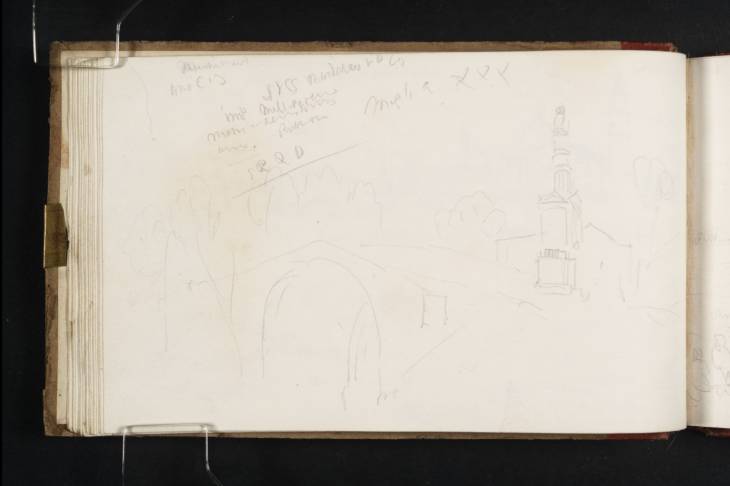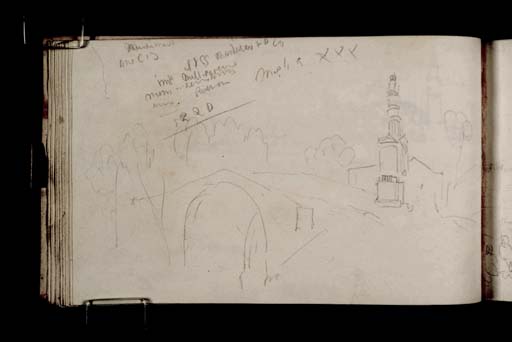Joseph Mallord William Turner A Small Bridge and ?a Roman Monument, Perhaps on the Rubicon at Savignano 1819
Image 1 of 2
Joseph Mallord William Turner,
A Small Bridge and ?a Roman Monument, Perhaps on the Rubicon at Savignano
1819
Joseph Mallord William Turner 1775–1851
Folio 21 Verso:
A Small Bridge and ?a Roman Monument, Perhaps on the Rubicon at Savignano 1819
D14528
Turner Bequest CLXXVI 21a
Turner Bequest CLXXVI 21a
Pencil on white wove paper, 111 x 184 mm
Inscribed by Turner in pencil with several lines from an inscription (see main catalogue entry)
Inscribed by Turner in pencil with several lines from an inscription (see main catalogue entry)
Accepted by the nation as part of the Turner Bequest 1856
References
1909
A.J. Finberg, A Complete Inventory of the Drawings of the Turner Bequest, London 1909, vol.I, p.517, CLXXVI 21a, as ‘A bridge and church tower’.
1984
Cecilia Powell, ‘Turner on Classic Ground: His Visits to Central and Southern Italy and Related Paintings and Drawings’, unpublished Ph.D thesis, Courtauld Institute of Art, University of London 1984, pp.82, 462 note 62.
1987
Cecilia Powell, Turner in the South: Rome, Naples, Florence, New Haven and London 1987, pp.24, 202 note 39.
The Turner scholar C.F. Bell annotated Finberg’s 1909 Inventory entry (‘A bridge and church tower’), crossing out the second element and plausibly writing: ‘Milestone’.1 The elaborate structure, with aedicule panels supporting a fluted column with what seems to be a statue at the top, may be a Roman monument, similar in form to that depicted in William Pars’s 1770 watercolour A Roman Monument at Igel in the Dutchy of Luxemburgh (Tate T09405).
Tantalisingly, Turner’s scrawled inscription appears to transcribe passages in Latin and/or Italian, presumably from a carved text. He recorded longer passages with much care later in the sketchbook (see folios 60 verso and 63 recto; D14598, D14603; Turner Bequest CLXXVI 56a, 59), so his lack of precision here may reflect haste in a travel break or perhaps the decayed state of the original, which includes ‘C I [backwards C]’, the variant Roman numeral form indicating 1000 (usually ‘M’), a few words effectively illegible beyond their capital letters, the phrase ‘Miglia XXX’ (thirty miles), and what reads as ‘S R Q D’ but probably indicates the familiar ‘SPQR’ initials (for Senatus Populusque Romanus).
Potentially the most interesting word is in the previous line, and may read ‘Rubicon’, indicating the river at the boundary of Cisalpine Gaul and Italy, which Julius Caesar famously crossed with his army in 49 BC, declaring that ‘the die is cast’ and precipitating civil war. The river is mentioned in the notes made from the 1815 edition of J.C. Eustace’s A Classical Tour through Italy in the contemporary Italian Guidebook sketchbook (Tate D13938; Turner Bequest CLXXII 4, transcribed and catalogued by Nicola Moorby), one line of which, between mentions of Cesena and Rimini, reads: ‘2 Miles in the Pisatello or Rubicon.’ Eustace discussed the controversy over the identity of the river, noting:
About two miles from Cesena flows a stream, called the Pisatello, supposed to be the ancient Rubicon. There stood on its northern bank an obelisk, with the decree of the senate and Roman people inscribed on its pedestal, and two other inscriptions on its sides. The French destroyed this obelisk. The slabs that formed the pedestal lay half-buried in a farm yard, about a hundred paces from the road, where we dug them up, and places them against the trunk of a tree.2
Eustace’s visit had been in 1802; it is unclear whether the monument had been reconstructed by 1819, or whether Turner even depicts the same place. Today, there is a monument to the event with a statue of Caesar beside the later bridge on the Via Giacomo Matteotti in Savignano sul Rubicone, midway between Cesena and Rimini; the town, which suffered severe damage in the Second World War including the destruction of its Roman bridge, was renamed in honour of the still somewhat debatable connection in the twentieth century, having previously been known as Savignano di Romagna.3
Cecilia Powell’s has noted that Turner ‘barely recorded’ his route between Venice and Bologna, roughly eighty miles to the south-west, making only a handful of sketches (folios 21 verso–24 recto; D14528–D14532; also folio 90 verso; D14652; Turner Bequest CLXXVI 86a, and the sketchbook’s Introduction);4 James Hamilton has characterised them as ‘nondescript’.5
Undated MS note by C.F. Bell (died 1966) in copy of Finberg 1909, Tate Britain Prints and Drawings Room, I, p.517.
John Chetwode Eustace, A Classical Tour through Italy, 7th ed., London 1841, vol.I, p.189; see the wider discussion, pp.189–92; Eustace had died in 1815, and the wording of the 1815 edition used by Turner subsequently remained unchanged.
See ‘Storia’, Comune di Savignano sul Rubicone, accessed 17 March 2017, http://www.comune.savignano-sul-rubicone.fc.it/ .
James Hamilton, ‘Turner’s Route to Rome’ in Hamilton, Nicola Moorby, Christopher Baker and others, Turner & Italy, exhibition catalogue, National Galleries of Scotland, Edinburgh 2009, p.42; see also James Hamilton, ‘Turner e l’Italia’ in Hamilton, Nicola Moorby, Christopher Baker and others, Turner e l’Italia, exhibition catalogue, Palazzo dei Diamanti, Ferrara 2008, p.43.
How to cite
Matthew Imms, ‘A Small Bridge and ?a Roman Monument, Perhaps on the Rubicon at Savignano 1819 by Joseph Mallord William Turner’, catalogue entry, March 2017, in David Blayney Brown (ed.), J.M.W. Turner: Sketchbooks, Drawings and Watercolours, Tate Research Publication, July 2017, https://www


